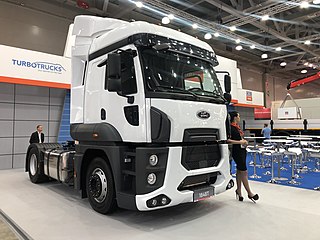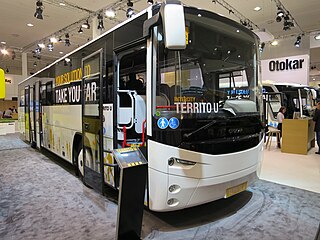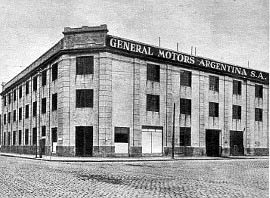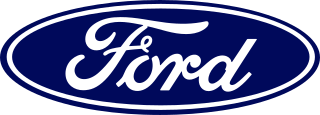Related Research Articles
Los Andes, founded on July 31, 1791 as Santa Rosa de Los Andes, is a Chilean city and commune located in the province of the same name, in Valparaíso Region. It lies on the route between Santiago and Chile's primary border crossing with Argentina by way of the summit of the Uspallata Pass in the Andes mountain range.

Hispano-Argentina was an Argentine automotive and engineering company that manufactured automobiles, military vehicles, engines, weaponry, and parts for public works.

The Ford Cargo is a forward-control (cab-over-engine) truck model manufactured by Ford since 1981. Designed by Ford of Britain as the successor of the Ford Transcontinental heavy commercial tractor, Ford introduced the Cargo to North America for 1986 as a medium-duty truck, intended to replace the long-running Ford C-Series.

Ford Argentina S.C.A. is the Argentine subsidiary of Ford Motor Company founded in Buenos Aires in 1913. Its first products were Model Ts assembled from complete knock down (CKD) kits provided by Ford Motor Company in 1917. Nevertheless, Ford Motor Argentina is best known in more recent times for producing the Ford Focus and, previously, the Argentine version of the Ford Falcon, originally a U.S. model introduced in Argentina in 1961, but adapted to the Argentine market.

Volkswagen Truck & Bus Indústria e Comércio de Veículos Ltda., formerly known as Volkswagen Caminhões e Ônibus, is a Brazilian commercial vehicle manufacturing company based in Resende, Brazil and a subsidiary of Traton. It manufactures heavy trucks and buses under the Volkswagen marque.

The Brazilian automotive industry is coordinated by the Associação Nacional dos Fabricantes de Veículos Automotores (Anfavea), created in 1956, which includes automakers with factories in Brazil. Anfavea is part of the Organisation Internationale des Constructeurs d'Automobiles (OICA), based in Paris. In 2021, the annual production exceeded 2.2 million vehicles, the 8th largest in the world.

The automotive industry in Turkey plays an important role in the manufacturing sector of the Turkish economy. The companies operating in the Turkish automotive sector are mainly located in the Marmara Region, especially Bursa.
This article provides an overview of the automotive industry in countries around the world.
Sevel Argentina S.A. was an Argentine automobile company established in 1981 that produced and marketed Fiat, Peugeot, Alfa Romeo, Chevrolet, and Citroën vehicles for the local market until it was dissolved in 1999. The company was created by merging Fiat's and Peugeot's Argentine operations.

The International TerraStar is a medium-duty truck that was manufactured by International Trucks from 2010 to 2015. The smallest conventional-cab truck ever produced by International, the TerraStar competed against chassis-cab vehicles derived from large pickup trucks along with the smallest versions of the Freightliner M2 and Hino 600. Though never officially designated by the company as a replacement for the 2006-2009 CityStar LCF COE, the TerraStar is of similar dimensions and GVWR.

Automotive production is a significant industry in Russia, directly employing around 600,000 people or 1% of the country's total workforce. Russia produced 1,767,674 vehicles in 2018, ranking 13th among car-producing nations in 2018, and accounting for 1.8% of the worldwide production. The main local brands are light vehicle producers AvtoVAZ and GAZ, while KamAZ is the leading heavy vehicle producer. Eleven foreign carmakers have production operations or are their plants in Russia.

With industrial production of USD $79.8 billion in 2023, Argentina is the third-largest industrial power in Latin America after Mexico and Brazil. Argentine industry is dominated by the food processing, chemicals, and motor vehicle sectors, which together drive almost 50% of gross value added in manufacturing.
Traton SE, known as the Traton Group, is a subsidiary of the Volkswagen Group and one of the world's largest commercial vehicle manufacturers, with its MAN, Scania, Navistar, IC Bus, Volkswagen Truck & Bus and Neoplan brands. The company also has digital services branded as RIO. In 2023, the group sold 338,183 vehicles. The range of products includes light-, medium-, and heavy-duty trucks, as well as vans and buses. As of December 31, 2023, Traton employed around 100,000 people in its commercial vehicle brands.

General Motors de Argentina S.R.L. is the Argentine subsidiary of the US-based company General Motors. The company is currently headquartered in Vicente López, Buenos Aires, with its factory located in Alvear, Santa Fe Province.

Toyota Argentina S.A. is the Argentine subsidiary of Japan-based conglomerate Toyota, being also the first Japanese automotive company to produce in Argentina. Established in 1994, the company has its manufacturing plant in Zárate, Buenos Aires, which opened in 1997.

Volkswagen Group Argentina is the Argentine subsidiary of German automotive manufacturing company Volkswagen Group. It was established in 1980 when the company acquired defunct business Chrysler Fevre Argentina including its two plants in San Justo and Monte Chingolo.

Ford Motor Company of Southern Africa (Pty.) Ltd. is an automobile and commercial vehicle manufacturer with corporate headquarters in Pretoria.

Chrysler Fevre Argentina S.A. was the Argentina subsidiary of US-based automotive manufacturer Chrysler Corporation. Originally established in 1890 as a supplier for tanning industry, the firm began to commercialise vehicles after an agreement signed with Dodge Brothers Company in 1916, which allowed it to import and commercialise automobiles and trucks in Argentina.
Stellantis Argentina S.A. is the Argentine subsidiary of international conglomerate Stellantis which produces and markets Citroën, Fiat, and Peugeot vehicles in the country. Established in 2021, the company is successor of several firms that had operated in Argentina as subsidiaries or licensors for these brands, such as Fiat Argentina, and Groupe PSA Argentina.

Mercedes-Benz Argentina S.A.U. is the Argentine subsidiary of international conglomerate Mercedes-Benz Group which produces and markets Mercedes-Benz utility vehicles in the country. The company was established in 1951 and has its assembly plant in Virrey del Pino, La Matanza Partido, where trucks and buses have been produced. Furthermore, MBA imports a wide range of luxury automobile models including sedans, SUVs, and AMG performance cars.
References
- ↑ "Cuentas nacionales, Vol. 8, n° 16, Ingreso nacional y ahorro nacional, Año 2023" (PDF). Instituto Nacional de Estadística y Censos de la República Argentina (INDEC). August 2024. Retrieved September 10, 2024.
{{cite web}}: CS1 maint: url-status (link) - ↑ "Mission and Objectives". Asociación de Fábricas de Automotores (ADEFA). September 10, 2024. Retrieved September 10, 2024.
{{cite web}}: CS1 maint: url-status (link) - ↑ "Autopartes: una de las industrias más importantes del país". Asociación de Fábricas Argentinas de Componentes (AFAC). September 10, 2024. Retrieved September 10, 2024.
{{cite web}}: CS1 maint: url-status (link) - ↑ "Comercio exterior, Vol. 8, n° 13, Intercambio comercial argentino, Cifras estimadas de julio de 2024" (PDF). Instituto Nacional de Estadística y Censos de la República Argentina (INDEC). August 2024. Retrieved September 10, 2024.
{{cite web}}: CS1 maint: url-status (link) - ↑ "Informe de Prensa: Evolución de la Producción, Exportaciones y Ventas a Concesionarios" (PDF). Asociación de Fábricas de Automotores (ADEFA). August 2024. Retrieved September 10, 2024.
{{cite web}}: CS1 maint: url-status (link) - ↑ Home | Asociación de Fabricantes de Automotores (ADEFA)
- ↑ ::: Materfer :::
- ↑ "Fábrica de carrocerías de buses y camiones (Terminal Automotriz) | Tecnología Avanzada en Transporte S.A. - TATSA". Archived from the original on 2016-11-23. Retrieved 2019-05-09.
- 1 2 Helvética remolques
- ↑ :: Establecimiento PurSang Argentina ::
- 1 2 1966: 1.000.000 de automotores argentinos (PDF) (in Spanish). Buenos Aires, Argentina: Asociación de Fábricas de Automotores. 1967. p. 2.
- ↑ "Los primeros años de Ford en Argentina". Ford Argentina. Retrieved August 18, 2024.
- ↑ 1966: 1.000.000 de automotores argentinos (PDF) (in Spanish). Buenos Aires, Argentina: Asociación de Fábricas de Automotores. 1967. p. 19.
- ↑ MacDonald, Norbert (1988). "Henry J. Kaiser and the Establishment of an Automobile Industry in Argentina". Business History. 30 (3): 337–340 – via Taylor & Francis Online.
- ↑ O'Keefe (1) and Haar (2), Thomas (1) and Jerry (2) (September 2001). "The Impact of MERCOSUR on the Automobile Industry". The North-South Agenda.
{{cite journal}}: CS1 maint: numeric names: authors list (link) - ↑ Watanabe, Marta (April 8, 2024). "China surpasses Argentina, supplying 40% of Brazil's imported cars". Valor International. Retrieved September 18, 2024.
{{cite news}}: CS1 maint: url-status (link) - ↑ "Brazil-Argentina new auto pact postpones free trade until 2029". Reuters. September 6, 2019. Retrieved September 19, 2024.
{{cite news}}: CS1 maint: url-status (link) - ↑ Martinez, Juan (August 23, 2022). "Brazil-Argentina agreement to boost auto trade by US$13 billion, says government". The Rio Times. Retrieved September 18, 2024.
{{cite news}}: CS1 maint: url-status (link) - ↑ "Toyota". Autohistoria. September 8, 2024. Retrieved September 8, 2024.
- ↑ "Ford Motor Company Pacheco Assembly Plant – Pacheco, Argentina". Ford Authority. September 8, 2024. Retrieved September 8, 2024.
- ↑ Foote, Brett (March 17, 2022). "FORD PACHECO ASSEMBLY PLANT EXPORTING RANGER TRUCKS FOR FIRST TIME". Ford Authority. Retrieved September 8, 2024.
{{cite news}}: CS1 maint: url-status (link) - ↑ Ferraresi, Fabio (June 18, 2024). "Ford To Manufacture Ranger Engines in Argentina". Power Systems Research. Retrieved September 8, 2024.
- ↑ Centeno, Deivis (March 5, 2024). "Production Restarts At GM Alvear Plant In Argentina". GM Authority. Retrieved September 8, 2024.
{{cite news}}: CS1 maint: url-status (link) - ↑ Centeno, Deivis (June 16, 2023). "GM To Increase Chevy Tracker Production In Argentina". GM Authority. Retrieved September 8, 2024.
{{cite news}}: CS1 maint: url-status (link) - ↑ "Volkswagen Argentina S.A." Volkswagen Newsroom. January 2024. Retrieved September 9, 2024.
- ↑ Aldaya, Francisco (December 15, 2022). "Volkswagen to Begin Manufacturing Buses, Trucks In Argentina". Bloomberg Línea. Retrieved September 9, 2024.
{{cite news}}: CS1 maint: url-status (link) - ↑ "Córdoba Plant". Renault Group. September 10, 2024. Retrieved September 10, 2024.
{{cite web}}: CS1 maint: url-status (link) - ↑ Smith, Federico (June 4, 2024). "Nissan Frontier: 100 Mil Unidades Producidas En Córdoba". Motorweb Argentina. Retrieved September 8, 2024.
{{cite news}}: CS1 maint: url-status (link) - ↑ "German companies confirmed investments in Argentina". Buenos Aires Herald. April 28, 2023. Retrieved September 10, 2024.
{{cite web}}: CS1 maint: url-status (link) - ↑ "Facts and figures: Mercedes-Benz Plant Buenos Aires". Mercedes-Benz Group AG. September 10, 2024. Retrieved September 10, 2024.
{{cite web}}: CS1 maint: url-status (link) - ↑ "Mercedes-Benz celebrates 70 years of production in Argentina". Automotive World. September 10, 2021. Retrieved September 10, 2024.
{{cite web}}: CS1 maint: url-status (link) - ↑ "Mercedes-Benz Buses will build a new facility in Argentina by 2026". Busworld Latin America. April 3, 2024. Retrieved September 10, 2024.
{{cite web}}: CS1 maint: url-status (link) - ↑ "Honda Announces Changes in Production Operations in Argentina". Honda Motor Company press release. August 14, 2019. Retrieved September 8, 2024.
{{cite news}}: CS1 maint: url-status (link) - ↑ "Smata, en alerta por despidos en la planta de Scania Tucumán, concesionarias y talleres". La Gaceta. July 4, 2024. Retrieved September 10, 2024.
{{cite news}}: CS1 maint: url-status (link) - ↑ Schillaci, Pablo (September 2024). "Oscar Jaern, CEO de Scania Argentina. "Tucumán produce a todo vapor"". VisionAuto. Retrieved September 10, 2024.
{{cite web}}: CS1 maint: url-status (link) - ↑ Pereyra, Carlos Alfredo (August 8, 2022). "Iveco Argentina: cifras de crecimiento y anuncios de proyectos". Motor1.com. Retrieved September 10, 2024.
{{cite web}}: CS1 maint: url-status (link) - ↑ "Iveco en Argentina". Iveco. September 10, 2024. Retrieved September 10, 2024.
{{cite web}}: CS1 maint: url-status (link) - ↑ "Comercio exterior vol. 1 nº 1. Intercambio Comercial Argentino (ICA). Cifras estimadas de diciembre de 2016" (PDF). Instituto Nacional de Estadística y Censos de la República Argentina (INDEC). January 2017. Retrieved September 18, 2024.
{{cite web}}: CS1 maint: url-status (link) - ↑ "Comercio exterior vol. 3 nº 1. Intercambio comercial argentino. Cifras estimadas de diciembre de 2018" (PDF). Instituto Nacional de Estadística y Censos de la República Argentina (INDEC). January 2019. Retrieved September 18, 2024.
{{cite web}}: CS1 maint: url-status (link) - ↑ "Balanza comercial argentina por secciones de la Nomenclatura Común del Mercosur. Años 2019-2023". Instituto Nacional de Estadística y Censos de la República Argentina (INDEC). September 18, 2024. Retrieved September 18, 2024.
{{cite web}}: CS1 maint: url-status (link) - ↑ "Comercio exterior. Vol. 8, n° 13. Intercambio comercial argentino. Cifras estimadas de julio 2024" (PDF). Instituto Nacional de Estadística y Censos de la República Argentina (INDEC). August 20, 2024. Retrieved September 18, 2024.
{{cite web}}: CS1 maint: url-status (link) - ↑ Guevara (1) and Fitzsimmons (2), Sebasitán (1) and Alejandro (2) (February 2023). "Wages, Price, and Profit: Protection and Value Capture in the Mercosur Automotive Industry". Latin American Perspectives. 50 (5) – via ResearchGate.
{{cite journal}}: CS1 maint: numeric names: authors list (link) - ↑ Cost, Effectiveness, and Deployment of Fuel Economy Technologies for Light-Duty Vehicles. Washington, D.C.: The National Academies Press. 2015. p. 249. ISBN 978-0-309-37388-3.
- ↑ "Memoria – Anuario 2023". Asociación de Fábricas de Automotores. 2024. Retrieved September 15, 2024.
{{cite web}}: CS1 maint: url-status (link) - ↑ Tamayo (1), Snowberg (2), and Buitrago (3), Jorge (1), Erik (2), and Jenyfeer Martínez (3) (January 20, 2021). Toyota and Its Labor Union in Argentina. HBS No. 9-721-394. Boston, MA: Harvard Business School Publishing.
{{cite book}}: CS1 maint: multiple names: authors list (link) CS1 maint: numeric names: authors list (link) - ↑ "Toyota Argentina can't find 200 new workers who have finished secondary education". MercoPress. August 10, 2021. Retrieved September 10, 2024.
{{cite news}}: CS1 maint: url-status (link) - ↑ "Coletiva de Imprensa Desempenho da Indústria Automobilística Brasileira" (PDF). Associação Nacional dos Fabricantes de Veículos Automotores (ANFAVEA). September 2024. Retrieved September 17, 2024.
{{cite web}}: CS1 maint: url-status (link) - ↑ Corso, Pablo (May 21, 2024). "Small inventors lead the charge on EVs in Argentina". Dialogue Earth. Retrieved September 17, 2024.
{{cite news}}: CS1 maint: url-status (link) - ↑ May, Tiana (August 30, 2024). "Argentina: Equipmake to Supply Zero Emission Drivetrains in Agrale Buses". Bus-News. Retrieved September 17, 2024.
{{cite news}}: CS1 maint: url-status (link) - ↑ "Chery Group's August Sales Exceeded 170,000 Vehicles! Overseas Expansion Has Progressed Steadily". Chery International. September 4, 2023. Retrieved September 17, 2024.
{{cite web}}: CS1 maint: url-status (link) - ↑ "Institucional: La marca Chery en el país y el mundo". Chery Argentina. September 17, 2024. Retrieved September 17, 2024.
- ↑ Goldstein, Steve (May 7, 2024). "Invest in Argentina, Musk says in post alongside Milei". MarketWatch. Retrieved September 17, 2024.
- ↑ "La Universidad Nacional de La Plata quiere poner en marcha su planta de baterías de litio". Periferia. August 26, 2024. Retrieved September 17, 2024.
{{cite news}}: CS1 maint: url-status (link) - ↑ "Argentina Lithium Announces US$90 Million Investment by Stellantis in ARS$ Equivalent". Argentina Lithium & Energy Corp. press release. September 27, 2023. Retrieved September 17, 2024.
{{cite news}}: CS1 maint: url-status (link) - ↑ "Industria manufacturera, Vol. 8, n° 22 (Julio 2024) Índice de producción industrial manufacturero". Instituto Nacional de Estadística y Censos (INDEC) de la República Argentina. September 2024. Retrieved September 9, 2024.
- ↑ Centeno, Deivis (March 5, 2024). "Production Restarts At GM Alvear Plant In Argentina". GM Authority. Retrieved September 9, 2024.
{{cite web}}: CS1 maint: url-status (link) - ↑ "Toyota busca reducir 400 puestos de trabajo y lanza plan de retiros voluntarios". ámbito. March 25, 2024. Retrieved September 17, 2024.
{{cite news}}: CS1 maint: url-status (link) - ↑ "VW Argentina lays off over 300 workers amid economic struggle". MarkLines. August 24, 2024. Retrieved September 17, 2024.
{{cite news}}: CS1 maint: url-status (link) - ↑ "Toyota presents plan to produce Hiace utility vehicle in Argentina". Agenzia Nova. February 16, 2024. Retrieved May 27, 2024.
- ↑ "Mercedes-Benz announces construction of a new truck and bus factory in Argentina". America Economia. March 22, 2024. Retrieved June 4, 2024.
- ↑ Estigarríbia, Juliana (April 25, 2024). "Stellantis Will Invest Billions to Manufacture New Models in Brazil, Argentina". Bloomberg Línea. Retrieved May 27, 2024.
- ↑ "Stellantis to invest $385 mln in Argentine plant". Reuters. September 6, 2024. Retrieved September 8, 2024.
{{cite news}}: CS1 maint: url-status (link) - ↑ Olmos, Marli (May 15, 2024). "Volkswagen opens truck factory in Argentina". Valor International. Retrieved September 17, 2024.
{{cite news}}: CS1 maint: url-status (link) - ↑ Ceriotto, Luis (August 21, 2024). "Honda invierte US$ 15 millones para exportar a Brasil piezas para motos". Clarín. Retrieved September 17, 2024.
{{cite news}}: CS1 maint: url-status (link) - ↑ "Renault anuncia una millonaria inversión para fabricar una pick up en Córdoba". Clarín. September 17, 2024. Retrieved September 17, 2024.
{{cite news}}: CS1 maint: url-status (link)